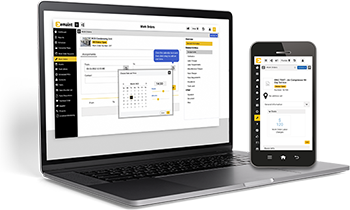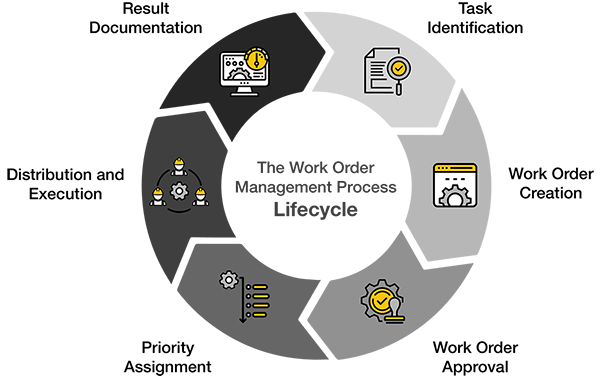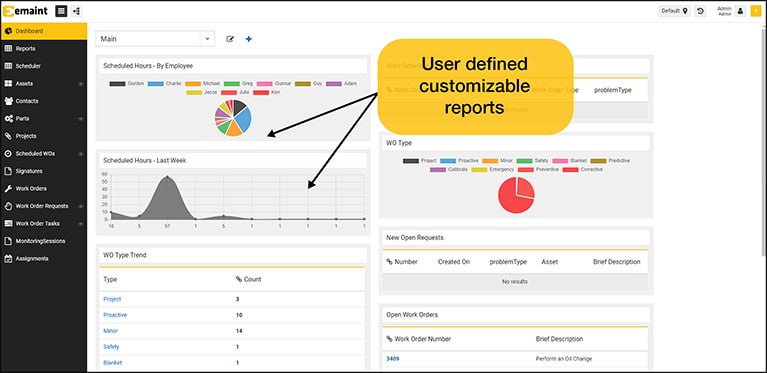What is a Work Order?
A work order is an authorized document issued for maintenance, repair, or operational tasks, specifying the work details, necessary resources, and instructions for completion. It is a critical tool that contains everything needed to complete maintenance tasks. It assists in managing, assigning, and tracking maintenance activities, ensuring they are executed efficiently and aligned with operational goals.
Work orders are a fundamental part of your maintenance operations, and when done well they help you and your team stay organized and get work done. A work order may include information such as:
- Who is requesting the work order
- Who is authorizing the work order
- The location of the task
- What the task is
- Who will perform the labor
- When the work order needs to be completed
- How to complete the task, including necessary parts and other notes
Work orders can be manually generated through a work request submitted by a staff member, client, or tenant. They can also be automatically generated through a work order management software or Preventive Maintenance (PM) schedule. Work orders can be generated via follow-ups to inspections or audits as well. Utilizing a CMMS like eMaint will help simplify the work order process.
What are the Types of Work Orders?
There are several types of work orders that an organization can use to manage its maintenance. Utilizing the right kind of work order is vital to keeping maintenance organized and efficient.
Inspection Work Orders: Inspection work orders schedule a technician to come and inspect a particular asset. If a problem is detected during an inspection work order, a new work order is created to resolve the issue. What triggers an inspection order will depend on your maintenance strategy.
Preventive Maintenance Work Orders: Preventive maintenance work orders are used to schedule routine servicing for all of your equipment. They can include routine cleaning, lubrication, and other preventive maintenance tasks to guarantee consistent asset performance.
Corrective Maintenance Work Orders: Corrective maintenance work orders are issued to fix new problems before they become serious. Technicians might discover an issue while performing routine inspections or your AI tools might diagnose a new fault in your equipment. A corrective maintenance work order can include repairing or replacing worn or damaged parts on your equipment.
Emergency Work Orders: Emergency work orders are created in response to an unexpected breakdown. These work orders require an immediate response to avoid costly downtime. When responding to emergency work orders, technicians should record why the asset failed, what was done to restore its normal operating condition, and provide recommendations for preventing this type of failure from occurring again.
Electrical Work Order: Electrical work orders are focused on the repair or installation of electrical equipment. This can be installing new wiring, fixing lights, or dealing with any power supply issues.
Special Project Work Order: Special project work orders are all about new and improved equipment. This is the type of work order that is required whenever a new asset needs to be installed. They can be used for any number of reasons such as improving the efficiency of operations or replacing aging equipment.
What is a Work Order Used For?
Work orders are used to formally track maintenance, repair, and service tasks within an organization. They provide detailed instructions and allocate resources for tasks, both documenting what needs to be done and providing the information needed to do it. Work orders help ensure that maintenance is carried out systematically and efficiently, reducing downtime and enhancing reliability. They also serve as proof of completed work, allowing for compliance with safety and regulatory standards. By using work orders, organizations can:
- Explain a problem, repair, or installation
- Schedule resources and tools needed for maintenance
- Provide technicians with detailed instructions
- Document the labor, materials, and resources used to complete the work
- Track all maintenance that has been performed on each asset
Why are Work Orders Important?
Work orders are vital to keeping manufacturing operations running smoothly and maximizing uptime. They make it possible to effectively schedule maintenance to increase the reliability and life expectancy of assets. Since a work order includes all the instructions needed to complete a maintenance task, it is essentially the backbone of any good maintenance plan.
The name of the game with work orders is efficiency. Traditionally, they’re all about streamlining and organizing the maintenance process. Using a CMMS work order management software takes those efficiency gains to the next level. Maintenance teams can keep accurate records about their assets, track labor and inventory costs, track trends in equipment breakdowns and estimate costs. Ultimately, it enables them to manage their equipment proactively by capturing insights across all their assets.
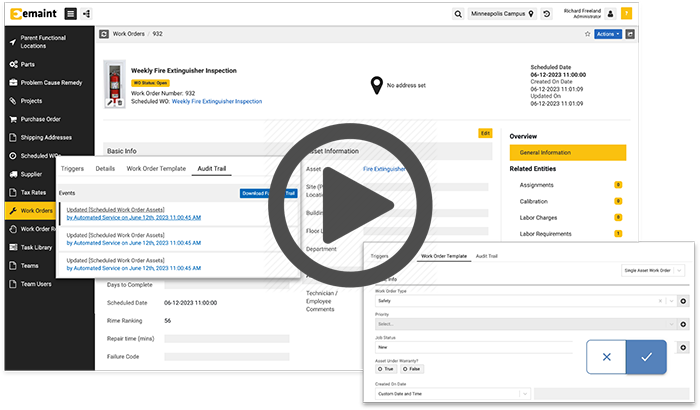
Work Order Process: Stages of a Work Order
There are six steps in the process of creating and approving a work order:
1. Identify the task
The work order process begins when there is a task that needs to be completed. This is often triggered by unforeseen problems like a new service request or an emergency. However, it can also be triggered by predefined activities like preventive maintenance tasks or routine inspections. The process is much simpler when the maintenance is planned and resources can be allocated ahead of time.
2. Create a new work request
Once the task is identified, a maintenance request is submitted to the maintenance team. For example, If a machine breaks down unexpectedly, a work request to repair it will be submitted. If a maintenance task is planned, a CMMS like eMaint can automatically issue a work request at the appropriate time.
3. Prioritize the work
When requests are submitted, it’s up to the maintenance team to determine the urgency and viability of the request. Some requests will be more time-sensitive than others, depending on their downstream impact. If the work request is approved, the proper personnel and parts will be determined and it will be converted into a work order.
4. Create a Work Order
Once the work request has been approved and properly prioritized, a work order is officially created. It should have all the information required to complete the task, with resources already allocated and ready.
5. Complete and document the work
The work order is then assigned to a technician to take action. They will complete the task and document what they did under the asset’s records.
6. Analyze the results
Don’t stop there. Maintenance may be done, but there is always room for improvement. Your work order history offers valuable insights into your equipment and your existing processes to drive continuous improvement. Be sure to measure and adjust as needed.
What Information to Include in a Work Order
Now that we’ve gone over the steps in the work order process, it is important to know exactly what should be included in a work order itself. Generally, a work order description should include:
- Who is authorizing the work order
- Who will perform the labor
- What the task is
- When the work order needs to be completed
- Where the work order needs to be performed
- How to complete the task, including necessary parts and other notes
Writing the actual work order is not as daunting as it might seem. It simply involves detailing the specific maintenance or task required. Begin by identifying the requester and providing contact information. Clearly describe the issue or task, including relevant details such as the location and equipment involved. Specify the priority level to help maintenance teams prioritize their work. Include any necessary attachments, such as photos or diagrams, that can provide additional context. Allocate resources, such as personnel and materials, that will be needed to complete the task. Finally, provide a target completion date to set expectations and help manage workloads. Using a structured format like this ensures that all essential information is captured, facilitating efficient and effective execution.
Best Practices for Managing Work Orders
Effective management of work orders involves several best practices.
- Ensure work orders are detailed and complete: A work order should provide all necessary information for task execution. Any absent information will cause a slow down in maintenance. Use a centralized system, like a CMMS, to track and manage work orders, ensuring visibility and accessibility.
- Standardize your process: Simplify the work order process by making it the same every time. Create a work order template and make sure everyone knows how to fill it out correctly. Introduce guidelines for submitting work requests and avoid inconsistency in your maintenance operations.
- Clearly define roles and responsibilities: Having clear roles in your work order process can help ensure more efficient and accurate task execution. By clarifying who is authorized to create, assign, prioritize, complete, and review work orders, you avoid duplication and unauthorized work. Foster clear communication between maintenance teams and requesters to address any questions or changes promptly.
- Establish your maintenance goals and KPIs: Clear goals and performance metrics provide a framework for evaluating your work orders. They help define your organization’s maintenance strategy and keep your team on track.
- Automate your work orders: Use a CMMS to automate work orders based on breakdowns, time-based, event-based, usage-based, and condition-based triggers. For example, eMaint makes it possible to automatically schedule work orders based on equipment health data, so you can resolve problems early before they lead to failure.
- Continuously analyze and improve your work order process: Remember, effective work order management isn’t a one-time task. It’s a continuous process of refinement and adaptation. Constantly analyze your process to ensure your team adheres to the established best practices. This in turn will enhance productivity and maintenance outcomes.
Work Orders Example
An effective work order should be clear, specific, and detailed. It must also be precisely worded to avoid confusion and provide a clear document trail of the asset’s maintenance history.
An example of a work order might be a document issued to repair a faulty HVAC system in an office building. It would specify the nature of the problem, the location, the technician assigned, necessary tools, estimated completion time, and any safety precautions.
Whenever a work order is created it should describe the problem at hand and should answer the following questions:
- Which asset needs to be repaired? Where is the asset located?
- Which parts, if any, need to be replaced?
- Which tools will the maintenance crew need to bring with them?
- How many workers are needed to perform this job? What kinds of skills do they need? Will you need to call in outside workers?
- What’s the timeline for performing this job? Is this a preventive maintenance project that must be done on a fixed date? Is this an urgent repair on a key asset that needs to be handled immediately?
- What costs are involved in this job?
- Who is requesting the job? Who authorized the work?
The Difference Between a Work Order vs. Work Request
There is a subtle but important distinction between work orders and work requests. A work request, also known as a service request, typically refers to a situation where a non-maintenance staffer or customer has submitted a request for maintenance. A work order refers to a maintenance task that has been authorized for the maintenance team to perform.
Work requests serve a different function, but they also look a little bit different. A work request briefly describes the issue to mark the start of a maintenance flow. It is usually classified by a type of industry, business, or the priority of the task, such as calling an emergency request if a chemical spill is discovered.
Meanwhile, a work order is only issued after a request has been approved, where the existing budget, criticality, and age of the asset are all taken into consideration. Only after a work order is created can work begin.
What is the Difference Between a Work Order and a Purchase Order or Invoice?
A work order, purchase order, and invoice serve very different purposes within an organization. A work order is for maintenance, detailing the tasks to be performed. In contrast, a purchase order is a document sent to suppliers to procure goods or services, specifying the items, quantities, and agreed prices. An invoice is a bill issued by a supplier to request payment for goods or services provided. A work order initiates maintenance tasks, a purchase order initiates purchasing activities, and an invoice facilitates financial transactions and payment processing.
What is the Difference Between Work and Maintenance Orders?
While we have mostly been referring to work orders as they apply to maintenance operations, they are more versatile than that. A work order can apply to various operational tasks, including maintenance, construction, or IT services, a maintenance order refers explicitly to work orders created for the upkeep, repair, or inspection of equipment and facilities. All maintenance orders are work orders, but not all work orders are maintenance orders.
Digitalize Work Orders to Improve Efficiency
Manually created work orders have long been part of the maintenance world. Though paper-based work orders can be easier in some ways, they do not perform well at scale. Paper work orders can result in communication delays, extra costs for data entry, and a headache from trying to store all of them safely. Most of all, they’re just plain slow. In today’s fast-paced maintenance world, paper-based work orders are inefficient — not to mention environmentally unfriendly.
Computerized Maintenance Management Systems help organizations embrace the power of cloud-based, online work order software and put an end to repeated phone calls, sticky notes, and missing paperwork. Centralizing and streamlining the work order process improves clarity and gets more work done on time.

Work Order Apps
A work order software app, also known as a mobile CMMS, is the smartphone or tablet version of a work order software. Work order software apps allow technicians to enter data from mobile devices as they complete work orders. For planning and scheduling preventive maintenance tasks, technicians can use their devices to track in-progress work orders, as well as assets that still need to be serviced. The app provides them with information about the historical performance and inspection records right at their fingertips, making on-site maintenance easier than ever.
The Benefits of Digital Work Order Software
Digital work order software, such as a CMMS, provides great benefits to help keep your maintenance operations running smoothly.
Improved efficiency: By replacing manual and often paper-heavy processes with automated digital workflows, maintenance teams can streamline and expedite tasks like creating, assigning, and tracking work orders. Furthermore, real-time status updates enable teams to quickly respond to changing circumstances. This enhanced speed and flexibility saves valuable time and resources and can help reduce unexpected downtime.
Reduce errors: Digital work order systems also help reduce the errors associated with manual data entry. Accurate data is crucial for both informed decision-making and compliance. By centralizing all information in a single, easy-to-access platform, CMMS software ensures consistent and reliable data.
Better Communication: Digital work order software helps facilitate communication among team members. With all data stored centrally and available in real-time, teams have instant access to all the information they need to carry out their work. This promotes transparency and collaboration, allowing for quicker issue resolution and preventing potential bottlenecks.
How to Use a CMMS for Work Order Management
Work orders are the heart of a maintenance program. The tools within a CMMS help organizations stay up to date on labor, projects, and resources. A CMMS can help organizations take control of their work backlog, boost productivity, and manage compliance. It is key to effective work order management.
What is Work Order Management?
Work order management refers to the process of prioritizing, completing, and documenting maintenance work orders on time. While this might sound simple, the process is time-consuming and prone to error when done by hand. Work orders filled out on paper and filed away in cabinets are easy to misplace, and manual spreadsheets are slow to be updated with new information. Instead, leveraging robust work order management software accelerates and streamlines this process while ensuring accurate, up-to-date documentation. When implemented effectively, this approach can be affordable and scalable in a facility, enabling maintenance teams to reduce unplanned asset downtime and save money.
Lifecycle of a Work Order: Work Order Management Process
The work order management process typically starts with a maintenance manager accepting a work request and transforming it into a robust work order. That is just the beginning though, as the entire process can be summarized through a lifecycle of six steps.
- Task Identification: Identify what needs to be done to resolve an issue.
- Work Order Creation: Complete a work request form to authorize maintenance tasks.
- Work Order Approval:Maintenance management decides if there is a legitimate need. If there is and completing the task in a reasonable amount of time is viable, the official work order will be written.
- Priority Assignment: Work orders are assessed by considering the urgency, existing backlog, and team availability.
- Distribution and Execution: Approved and prioritized work orders are printed and given to technicians to perform the required activity.
- Result Documentation: Workers document what occurred in an accurate and timely manner. The work order can be closed once all services are rendered and the job is complete.
What are the Different Work Order Management Approaches?
The two primary approaches to work order management are manual and automated. A manual approach involves using pen and paper, spreadsheets, whiteboards, or some combination of all three. An automated approach leverages work order management software to automate work order creation and documentation workflows.
Manual work order methods were once all that were available to maintenance teams. They can easily still be effective for smaller organizations that handle a low volume of work orders. However, a CMMS is a far more reliable system that makes it easy to prioritize work orders without having to sift through a mountain of paperwork. It can automatically distribute work orders to available technicians, and instantly update maintenance records with real-time information.
Managing Work Order Requests
Not all work can be planned ahead of time. There has to be a request system for when corrective work is required or customer needs arise. Maintenance managers should tailor workflow processes for request submission, approval, rejection, and completion to the specific needs of their organization. Identifying a workflow process ahead of time ensures:
- Standard Operating Procedures (SOPs) are adhered to by all users
- Work goes through an approval process
- Areas of responsibility and expectations are clear for users
- Periodic process auditing is performed
- Valid data is being entered into a CMMS
- Efficient communication flow between all parties
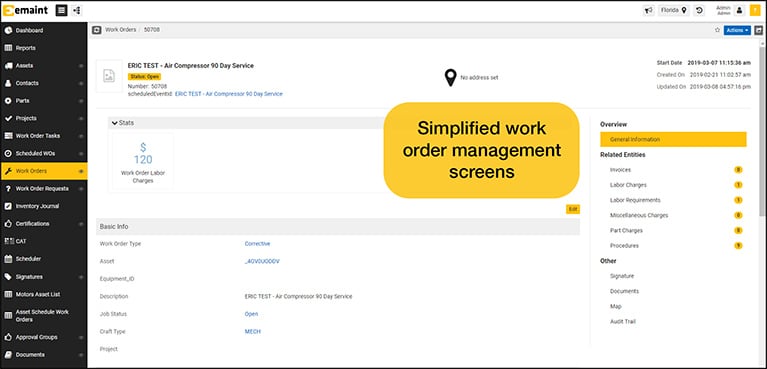
With eMaint, organizations can choose from three work order request submission options:
- Work requestors are given an eMaint user login that allows them to submit requests and view the history and status of those requests
- Work requestors send an email to a designated email address that gets converted into an eMaint work request
- Work requestors submit requests to eMaint through a customized web form embedded on a company’s website or intranet
Work request tools like these reduce communication errors. Organizations can send requestors automated email alerts when a work request is approved or rejected, followed by an automated email alert with a satisfaction survey once work has been completed.
With modern mobile CMMS solutions, requestors can submit work order requests whenever and wherever they are using their mobile device. Requestors can attach pictures to their requests, including the equipment needing repair.
What is Work Order Software?
Work order software makes it easy for organizations to increase on-time work completion, improve workflow efficiency, keep track of project due dates, and more.
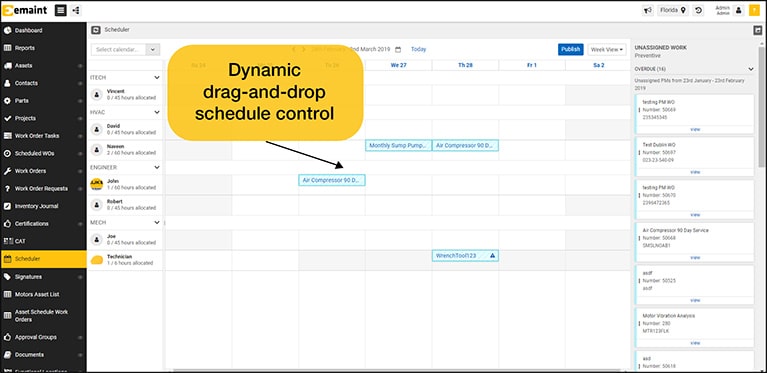
- Work Order Assignment – Using features such as eMaint’s maintenance scheduling tools, maintenance planners and schedulers can directly assign work orders to staff, contractors, or vendors for specific days, times, and locations. Assigned and unassigned work orders can also be viewed on a calendar display, and work can easily be reassigned when necessary.
- Scheduling Calendar – View a calendar by day, week, or month with all labor resources and open work orders. You can also adjust calendar views and filter work by employee, work order type, and more. Organizations can also use the PM Projection feature to plan upcoming work and ensure the right parts, labor, and tools are available.

- Reports & Dashboards – Leverage Reports & Dashboards to stay up to date. Categorize work orders by type, technician, department, or any other user-defined field.
- Mobile Maintenance – Using mobile CMMS maintenance services such as eMaint’s MX Mobile, organizations can access real-time data and perform functions throughout their facilities and on the road, including submitting and approving work requests, signing and closing out work orders, and more.
- Tracking Projects – Major overhaul and renovation projects can be a headache, but the management process doesn’t need to be. With eMaint’s project management tools, organizations can easily create projects and assign and track work orders from project inception to completion. Assets, inventories, and actions that impact operational goals can all be handled from one platform. With Gantt Charts, users can get a clear visual understanding of work order completion rates compared to a project’s end date.
Work Order Frequently Asked Questions
What Does Work Order Mean?
Work order means, simply put, an order for maintenance work. A work order is a document or digital task that details maintenance work, parts, and processes for assets. Work orders are key to organizing a maintenance strategy.
What is a Maintenance Work Order?
A maintenance work order is a formal directive that authorizes specific maintenance tasks on equipment or facilities. It details the job description, necessary resources, and execution steps, providing a structured approach for maintenance teams. It is essential for tracking, scheduling, and ensuring the accountability of maintenance operations.
What’s the Difference Between a Work Request and a Work Order?
A work request is an informal notification of an issue or a needed task, typically submitted by staff or customers. In contrast, a work order is a formal document issued in response to a work request, authorizing and detailing the specific tasks required. It includes assigned resources, timelines, and instructions, providing actionable steps to complete whatever work is needed.
What is the Purpose of a Work Order System?
The purpose of a work order system is to streamline and manage the process of handling maintenance tasks from initiation to completion. It helps track progress, schedule resources, and maintain historical records of the work done. Using one to manage work orders helps improve operational efficiency and asset management.
How to Fill out a Maintenance Work Order?
To fill out a maintenance work order effectively make sure it includes all of the following information:
- Description of Issue: Clearly describe the problem or maintenance task.
- Location: Specify where the work is to be performed.
- Priority: Assign a priority level to guide timely action.
- Assigned To: Detail who is responsible for completing the task.
- Estimated Time: Provide an estimate of how long the task should take.
- Required Tools and Materials: List all necessary tools and materials.
- Safety Notes: Include any safety precautions or relevant regulations.
What are the Functions of a Work Order?
The functions of a work order include:
- Authorization: Legitimizing the commencement of a task.
- Documentation: Providing a record of tasks, resources, and time.
- Coordination: Ensuring resources are scheduled and available.
- Tracking: Monitoring progress and status updates.
- Analysis: Offering data for operational insights and future planning.
What Should be in a Work Order?
A work order should contain:
- Work Description: Detailed explanation of the task.
- Requestor Information: Who requested the work, and their contact information.
- Assigned Personnel: Names and roles of individuals responsible for execution.
- Timeline: Start and end dates, including any milestones.
- Resources: List of materials and equipment needed.
- Instructions and Standards: Specific procedures or standards to follow.
- Approval Signatures: Sign-offs are required to start and complete the work.

